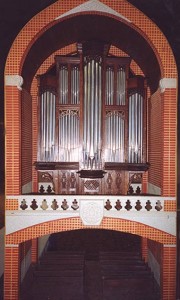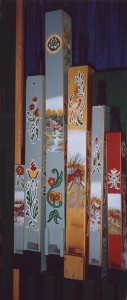Organ stop pictures by Lou Hurst. Organ facade and building exterior pictures by Lana Krakovskiy.
Organ stop pictures by Lou Hurst. Organ facade and building exterior pictures by Lana Krakovskiy.
 Dr. William F. Entriken, Organist and Choirmaster of First Presbyterian Church (l) and Sebastian M. Glück (r) after dedicatory recital of Opus 8 last Fall |
|
| The Sebastian M. Glück Opus 8 was inaugurated in the Fall of 2003. A new CD, “A Small Wonder: Music from Alexander Chapel” has just been released and is available for purchase through First Presbyterian Church. Recorded by Dr. William F. Entriken and produced by Dr. Entriken and Mr. Glück, this CD highlights the many wonderful features of the exquisite instrument now gracing the Alexander Chapel.
Listen to samples (MP3):
From the CD notes and Glück New York Website: The jewel-box Tudor chapel comfortably seats about fifty people, its gilded plaster ceiling, oak-paneled walls, and slate floor providing a visual feast.Designed and tonally finished by Sebastian M. Glück, this amazing instrument occupies a footprint of only 34 x 120 inches. The pipework is fashioned of red oak, poplar, walnut, planed 50% tin, and flamed copper for the basses of the 8′ Dulciana which flank the main soundboard. The 16′ Double Dulciana utilizes free reeds in the manner of a 19th century French harmonium, with a seamless transition to the bottom octave. An unusual tonal feature is the 4/5′ Choral Bass, which when drawn with the 4′ and 2′ flutes, provides a horn-like, reedy cantus firmus voice. The organ’s pipework is unenclosed, but the keydesk features a balanced expression pedal for practice purposes. CD is $15 and is available at the church office, |
 Close-up of the flamed copper 8′ Dulciana |
|
|
|
  Courtesy of Sebastian M. Glück
|
|
The exhibits at the convention were comprised of music dealers, organ builders, artist representatives and (too many) electronic organ companies. I hung around while everyone was setting up their displays. (This was not unlike any number of the techie conventions in Javits Center, just less noisy and a little less crowded).
Since size and weight would make it difficult to bring an entire pipe organ in for the show, most builders resorted to a display of a few pipes for demonstration purposes. One Canadian company (Casavant Freres) created a little model of a church: |
Others raffled off pipes painted by Pennsylvania Dutch folk artists: |
But the German company Oberlinger Orgelbau brought an entire organ to the show! They put it together on the spot.
Lively-Fulcher organ at University of Utah, Gardner Concert Hall
Organ Specification at the Osiris Archive
The new Lively-Fulcher pipe organ built for the Gardner Concert Hall on the University of Utah campus in Salt Lake City was installed and completed by May 2000. The instrument has 58 speaking stops playable over five divisions, Grand Orgue, Recit Expressif, Positif Expressif, Bombarde and Pedale. The three manual and pedal key actions are mechanical while the stop action is electric complete with state of the art combination action and 256 levels of memory. The wind supply is regulated by a traditional bellows system linked to the wind chests by wind lines constructed of wood. The console is attached to the main organ case in center position and has natural keys covered in bone and sharp keys of solid ebony. The internal layout of the divisions within the case places the Positif Expressif centrally above the console and the Grand Orgue above that with the Recit Expressif behind the GO. The Bombarde is divided either side of the GO with the Pedal division also divided either side the manuals and behind the 16-foot Pedal towers in the case.
The casework design, constructed of natural curly figured Cherry wood, takes its inspiration from the contemporary accents associated with this room yet with a firm traditional footing found as the basis for the Gardner Hall architecture. The ‘stepped’ feature in the case follows the same theme from the ceiling and walls of the Hall and the traditional towers take their cue from the more traditional ‘coffin’ like shape of the room. The façade pipes are of 72% tin and include pipes from the GO Montre 16′, Montre 8′ and Pedal Montre 8′. The pipe shades are formed with a two layered geometric design showing the front layer in gold and the back in contrasting green. The design includes two Sego Lily motif’s (Utah State flower) depicted in the Positif case forging a firm link between the organ case and Utah University. The organ is completely housed within its own freestanding casework and is positioned at the front of the Hall above the orchestra stage and behind the choir seating. The Hall’s warm and generous 4.5-second acoustic can be regulated in infinite degrees to 1.5 seconds reverberation time which offers the University a remarkable and optimum setting for performance of all types of music.
The tonal inspiration for the instrument is firmly based in 19th century France but is designed and voiced with a broad literature base in mind due to the varied use that the organ will need to respond to at this modern University. The Tutti is voiced to balance a full symphony orchestra for organ concerti and symphonic literature alike but includes two enclosed divisions with a good variety of soft colors so necessary for the accompaniment of solo voices and other instruments. The warm yet clear polyphonic competence of broadly scaled principal chorus work carefully blended with the sonorous mutations and reed colors associated with Cliquot and Cavaille-Coll make for an exceptionally versatile medium for the main body of the organ literature today. The broad foundation tone of the 8-foot stops and thick walled expressiveness of the Recit and Positif boxes ensure the accompanimental versatility so necessary for the performance of the choral literature and much more besides. The careful voicing and blending of individual stops coupled with the balancing and color requirements so important to specific areas of the French, German and English literature ensure a convincing performance of the wide body of literature that is expected from concert organs of today.
© Paul Fulcher and Mark Lively
Lively-Fulcher Pipe Organ Builders
Images, © Paul Fulcher and Mark Lively
Cavaille-Coll 1884 III/P/58. 18th Century case.
Sounds of the organ in Abbaye aux Hommes
Images, © Cor Roeleveld
Sites to visit:
http://www.culture.fr/culture/cavaille-coll/en/
http://st-etienne.ifrance.com/st-etienne/
http://www.bluffton.edu/~sullivanm/caen/hommes.html
The 1543 case of the Grand Organ at Caudebec en Caux, France.
Images, © Cor Roeleveld
An excellent site about organs of Normandy:http://www.multimania.com/blecoq/orgues/accueil.htm
Organ crawls into the magnificent Manders in New York City.